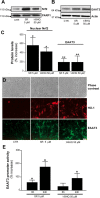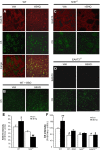Nuclear factor erythroid 2-related factor 2 facilitates neuronal glutathione synthesis by upregulating neuronal excitatory amino acid transporter 3 expression
- PMID: 21593323
- PMCID: PMC3339848
- DOI: 10.1523/JNEUROSCI.6577-10.2011
Nuclear factor erythroid 2-related factor 2 facilitates neuronal glutathione synthesis by upregulating neuronal excitatory amino acid transporter 3 expression
Abstract
Astrocytes support neuronal antioxidant capacity by releasing glutathione, which is cleaved to cysteine in brain extracellular space. Free cysteine is then taken up by neurons through excitatory amino acid transporter 3 [EAAT3; also termed Slc1a1 (solute carrier family 1 member 1)] to support de novo glutathione synthesis. Activation of the nuclear factor erythroid 2-related factor 2 (Nrf2)-antioxidant responsive element (ARE) pathway by oxidative stress promotes astrocyte release of glutathione, but it remains unknown how this release is coupled to neuronal glutathione synthesis. Here we evaluated transcriptional regulation of the neuronal cysteine transporter EAAT3 by the Nrf2-ARE pathway. Nrf2 activators and Nrf2 overexpression both produced EAAT3 transcriptional activation in C6 cells. A conserved ARE-related sequence was found in the EAAT3 promoter of several mammalian species. This ARE-related sequence was bound by Nrf2 in mouse neurons in vivo as observed by chromatin immunoprecipitation. Chemical activation of the Nrf2-ARE pathway in mouse brain increased both neuronal EAAT3 levels and neuronal glutathione content, and these effects were abrogated in mice genetically deficient in either Nrf2 or EAAT3. Selective overexpression of Nrf2 in brain neurons by lentiviral gene transfer was sufficient to upregulate both neuronal EAAT3 protein and glutathione content. These findings identify a mechanism whereby Nrf2 activation can coordinate astrocyte glutathione release with neuronal glutathione synthesis through transcriptional upregulation of neuronal EAAT3 expression.
Figures








Similar articles
-
Prion protein regulates glutathione metabolism and neural glutamate and cysteine uptake via excitatory amino acid transporter 3.J Neurochem. 2015 May;133(4):558-71. doi: 10.1111/jnc.13071. Epub 2015 Mar 17. J Neurochem. 2015. PMID: 25692227
-
The neuronal excitatory amino acid transporter EAAC1/EAAT3: does it represent a major actor at the brain excitatory synapse?J Neurochem. 2006 Aug;98(4):1007-18. doi: 10.1111/j.1471-4159.2006.03978.x. Epub 2006 Jun 27. J Neurochem. 2006. PMID: 16800850 Review.
-
SorCS2 Controls Functional Expression of Amino Acid Transporter EAAT3 and Protects Neurons from Oxidative Stress and Epilepsy-Induced Pathology.Cell Rep. 2019 Mar 5;26(10):2792-2804.e6. doi: 10.1016/j.celrep.2019.02.027. Cell Rep. 2019. PMID: 30840898 Free PMC article.
-
The glutamate transporters EAAT2 and EAAT3 mediate cysteine uptake in cortical neuron cultures.J Neurochem. 2003 Mar;84(6):1332-9. doi: 10.1046/j.1471-4159.2003.01630.x. J Neurochem. 2003. PMID: 12614333
-
The importance of the excitatory amino acid transporter 3 (EAAT3).Neurochem Int. 2016 Sep;98:4-18. doi: 10.1016/j.neuint.2016.05.007. Epub 2016 May 24. Neurochem Int. 2016. PMID: 27233497 Free PMC article. Review.
Cited by
-
Inhibition of GTRAP3-18 may increase neuroprotective glutathione (GSH) synthesis.Int J Mol Sci. 2012;13(9):12017-12035. doi: 10.3390/ijms130912017. Epub 2012 Sep 20. Int J Mol Sci. 2012. PMID: 23109897 Free PMC article. Review.
-
The Role of Non-Coding RNAs in the Neuroprotective Effects of Glutathione.Int J Mol Sci. 2021 Apr 19;22(8):4245. doi: 10.3390/ijms22084245. Int J Mol Sci. 2021. PMID: 33921907 Free PMC article. Review.
-
Reactive astrocytes overexpress TSPO and are detected by TSPO positron emission tomography imaging.J Neurosci. 2012 Aug 8;32(32):10809-18. doi: 10.1523/JNEUROSCI.1487-12.2012. J Neurosci. 2012. PMID: 22875916 Free PMC article.
-
The conserved SKN-1/Nrf2 stress response pathway regulates synaptic function in Caenorhabditis elegans.PLoS Genet. 2013 Mar;9(3):e1003354. doi: 10.1371/journal.pgen.1003354. Epub 2013 Mar 21. PLoS Genet. 2013. PMID: 23555279 Free PMC article.
-
N-acetylcysteine Provides Cytoprotection in Murine Oligodendrocytes through Heme Oxygenase-1 Activity.Biomedicines. 2020 Jul 23;8(8):240. doi: 10.3390/biomedicines8080240. Biomedicines. 2020. PMID: 32717964 Free PMC article.
References
-
- Alam J, Stewart D, Touchard C, Boinapally S, Choi AM, Cook JL. Nrf2, a Cap‘n’Collar transcription factor, regulates induction of the heme oxygenase-1 gene. J Biol Chem. 1999;274:26071–26078. - PubMed
-
- Aoyama K, Suh SW, Hamby AM, Liu J, Chan WY, Chen Y, Swanson RA. Neuronal glutathione deficiency and age-dependent neurodegeneration in the EAAC1 deficient mouse. Nat Neurosci. 2006;9:119–126. - PubMed
-
- Aoyama K, Matsumura N, Watabe M, Nakaki T. Oxidative stress on EAAC1 is involved in MPTP-induced glutathione depletion and motor dysfunction. Eur J Neurosci. 2008a;27:20–30. - PubMed
-
- Aoyama K, Watabe M, Nakaki T. Regulation of neuronal glutathione synthesis. J Pharmacol Sci. 2008b;108:227–238. - PubMed
-
- Bianchi MG, Gazzola GC, Cagnin S, Kagechika H, Bussolati O. The ATRA-dependent overexpression of the glutamate transporter EAAC1 requires RARbeta induction. Biochim Biophys Acta. 2009;1788:1861–1868. - PubMed
Publication types
MeSH terms
Substances
Grants and funding
LinkOut - more resources
Full Text Sources
